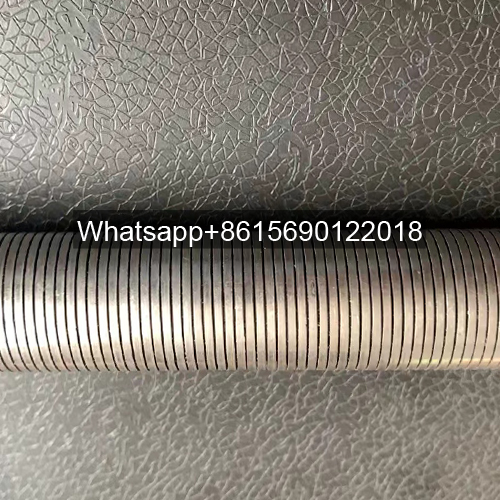What is a T-Type Finned Tube?
A T-Type Finned Tube is a high-efficiency heat exchange tube formed by rolling a plain tube.

T-Type Finned Tube, also known as Gewa-T Tube or T-Tube, is a high-efficiency heat exchange element. A spiral, ring-shaped T-shaped tunnel structure is machined onto the surface of a plain tube using a non-cutting rolling process. This structure generates localized negative pressure by allowing bubble nuclei within the tunnel to expand and eject, driving a continuous influx of low-temperature liquid, achieving cyclic boiling. Its boiling heat transfer coefficient can reach 1.6-3.3 times that of a plain tube, and the startup temperature difference only requires 2-4°C.
T-shaped finned tubes demonstrate significant heat transfer advantages in working fluids such as R113, Freon 11, and liquid ammonia. Experimental single-tube heat transfer coefficients can reach up to 10 times that of bare tubes. Industrial applications have shown that this tube material can reduce reboiler heat transfer area by over 30%, while also exhibiting anti-fouling properties and increasing critical heat load.
Principle of T-Type Finned Tubes
T-shaped finned tubes are high-efficiency heat exchange tubes formed by rolling bare tubes. Their structural characteristic is a series of spiral T-shaped tunnels formed on the outer surface of the tube. When the medium outside the tube is heated, a series of bubble nuclei form within the tunnels. Due to the surrounding heat within the tunnel cavity, the bubble nuclei rapidly expand and fill the inner cavity. Continued heating causes the pressure within the bubbles to rapidly increase, prompting the bubbles to rapidly eject from the fine cracks on the tube surface. The ejection of bubbles carries a strong impact force, generating a certain local negative pressure, forcing the surrounding, cooler liquid to flow into the T-shaped tunnels, resulting in continuous boiling. This boiling method removes far more heat per unit surface area per unit time than bare tubes, resulting in a higher boiling heat transfer capacity.
Applications of T-Type Finned Tubes
T-Type finned tubes are used in refining equipment such as alkylation units and depropanizers. Materials include carbon steel, stainless steel, and alloy steel. These tubes are suitable for boiling heat transfer conditions with clean shell-side media and are not suitable for media containing solid particles or prone to coking.
Features of T-shaped finned tubes
⑴ Excellent heat transfer. In R113 working fluid, the boiling heat transfer coefficient of T-shaped tubes is 1.6-3.3 times higher than that of bare tubes.
⑵ In conventional bare tube heat exchangers, the cold medium will bubble and boil only when the temperature of the hot medium is 12-15°C higher than the boiling point or bubble point of the cold medium. T-shaped finned tube heat exchangers only require a temperature difference of 2-4°C for the cold medium to boil, and the bubbling is fine, continuous, and rapid, offering a unique advantage over bare tubes.
⑶ Single-tube experiments using Freon 11 as the medium have shown that the boiling heat transfer coefficient of T-shaped tubes can reach 10 times that of bare tubes. Experiments with small tube bundles using liquid ammonia have shown that the overall heat transfer coefficient is 2.2 times that of bare tubes. Industrial calibration of reboilers in C3 and C4 hydrocarbon separation towers has shown that the overall heat transfer coefficient of T-shaped tubes is 50% higher than that of smooth tubes at low loads and 99% higher at high loads.
4. Cheaper than aluminum porous surface heat transfer tubes.
5. Due to the intense gas-liquid turbulence inside the tunnel and the high-speed gas ejection along the T-slot, scaling is less likely to form on either the inside of the T-slot or the outer surface of the tube. This ensures the long-term operation of the equipment without affecting heat transfer performance due to scaling.
Heat transfer mechanism of T-shaped finned tubes
From low to high heat load, the heat transfer in the T-tube tunnel can be divided into the following five different stages:
(1) Natural convection heat transfer before steam lock occurs;
(2) Local liquid film evaporation during periodic growth and detachment of the top tunnel vapor phase and convection heat transfer during the corresponding liquid circulation in and out of the tunnel;
(3) Bubble nucleation boiling heat transfer in the tunnel;
(4) Evaporation heat transfer of thin liquid film on the inner wall of the tunnel;
(5) Film heat transfer after the tunnel surface is evaporated or burned.
